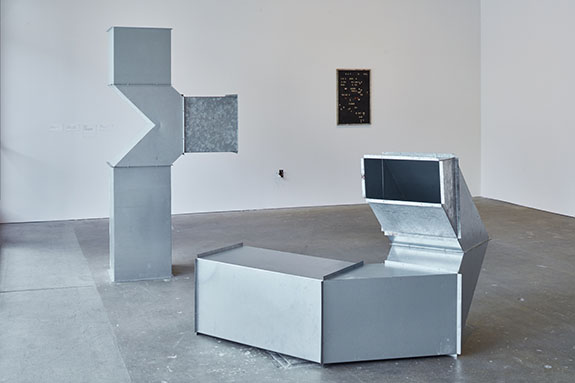
by Glen Helfand
There’s a ghost in the machine. Or is the machine a ghost? These digital days the boundaries are blurrier, making it more difficult than ever to parse the distinctions between hardware and software. Is a driverless car the real machine or the companies that, ominously, produce them? Our dysfunctional government is a system, a political machine, or even an engine. Hardware is the machine, software the activating force that seems to complicate Cartesian mind/body belief systems. In the framework of Mechanisms, a group exhibition curated by Anthony Huberman, the machine is a body, the ghost its energizing lifeblood or, perhaps, its spirit. The gallery itself is a shell in which artworks suggest a kind of action. I would qualify, though, that the show’s philosophical tone isn’t exactly about belief (though two elusive works by Trisha Donnelly do offer suggestions of portals to other worlds via a sound system and video static) — the show explores how systems virally insinuate themselves into our lives, attaching to us, for better or worse to prove, if nothing else, that that smart phone isn’t the only device that addictively connects to (and colonizes) every aspect of our lives.
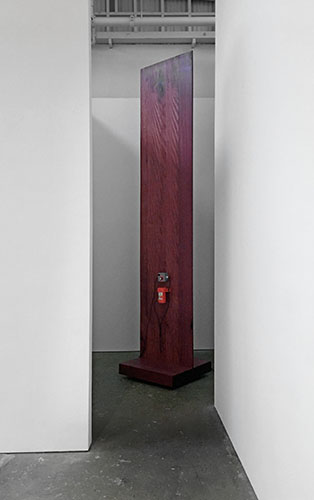
There’s more visual panache in the second gallery where we are greeted by Lutz Bacher’s large-scale wall of 26 half-orbs, objects the checklist describes as mirror surveillance domes. It’s titled Cyclops (the wall label notes a mysteriously specific creation date—27 March 2017) and has an earnest disco dazzle as it multiplies a convenience store fixture. We see ourselves distorted 26 times in these objects, and perhaps they see us. The domes frequently contain video cameras behind the one-way mirrored surface, cameras that are the seer, the technological force that activates these objects even further, though it’s a question if there are lenses behind these structures.
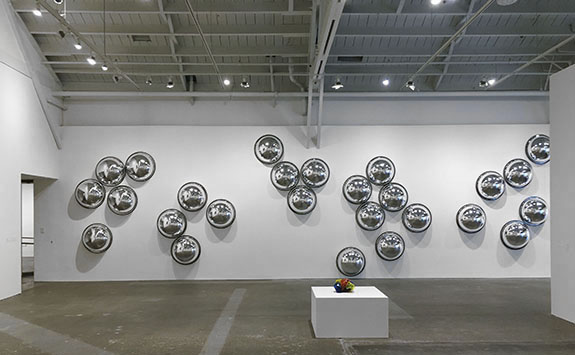
It’s this Big Brother implication that gives Huberman’s curatorial premise its human punch. As viewers, we are implicated and vulnerable as we enter, knowingly or unwittingly, into such power transactions on a daily basis. Bacher’s piece is in dialogue with an even larger photomural by Louise Lawler: a photograph printed on adhesive vinyl of a gallery interior, digitally stretched to fit to the contours of one very long wall. The distortion, like that of Cyclops, is akin to what, in a different era, could only be seen in a funhouse mirror. It perfectly reflects the malleable and sometimes insidious fictions enabled by cheap digital imaging technology. Its lengthy title acknowledges its appearance in previous spaces — Formica (adjusted to fit, distorted for the times, slippery slope 1), 2011/2012/2015/2017. — but it also alludes to the warped, politically suspect implications of hallowed art spaces.
These two are the largest, most visually commanding works in the show, but there are more forceful conceptual gestures that appear nearby. Disgorgement, 2016, another work by Cameron Rowland, is a dry-looking multi-page document framed under glass. The text describes a financial trust rooted in a provocative premise and a shameful racial history in which American insurance companies issued policies to slave owners on the lives of their property.
 |
In this instance, the artist purchased shares in a company (Aetna) that issued such policies; the idea being that the value will compound until the US government makes financial reparations for slavery—which is to say, probably never. (It relates to a 1989 bill introduced by Rep. John Conyers that went absolutely nowhere, and by a similar bill that passed the California legislature in 2000.) The mechanisms of capitalism are spinning in this gesture, trapped as they are in the ether of a contract, and they’re cleverly undermined — though you may need to be in the business to really appreciate the legalese.
Danh Vo’s Twenty-Two Traps, 2012, is an appropriation of rusty antique animal traps that evokes similarly violent actions, they feel poised to be sprung as we encounter them, dangerous and capable of inhumane treatment. Their tension is palpable, and in context they suggest 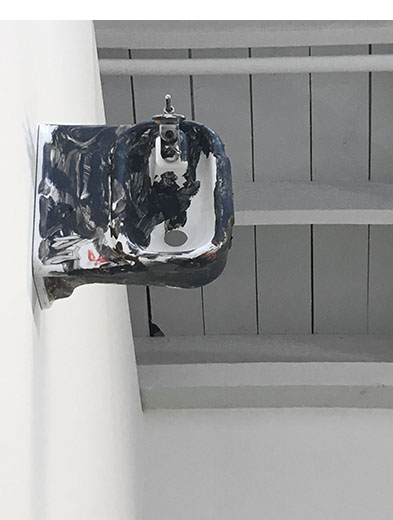
All of this dovetails with previous shows at The Wattis Institute over the past few years that betray Huberman’s interest in the dynamics of mechanics. I’m thinking of Camille Blatrix’s Roomba robot-like installation (of which the curator wrote the mechanized objects “they are impeccably fabricated but fraught with emotional entanglement.”) and of Sam Lewitt’s More Light than Heat, in which the artist utilized heaters that siphoned the energy of the lighting system to generate warmth. Even Laura Owens’ Ten Paintings project involved embedded speakers in the wall, voices that were triggered by the invisible WiFi connections of cell phones. I recalled these works while wandering through Mechanisms, thinking about the sense of a gallery as machine, a cycle of temporary presentations.
This is the largest group show mounted in this iteration of The Wattis. It spills into an adjacent room as large as the main gallery, where the connections between the objects loosen a bit and get a little more playful, yet still display an institutional color scheme. It’s here that we learn about the glitchy typeface that is used for all the show’s wall text: It’s The Letter E by Garry Neill Kennedy, a work that began in 1980 when he used an altered typewriter to create a typographical flaw that is rooted in a machine — the typewriter itself had an identity, an authorship, and it applies to the entire exhibition’s texts.
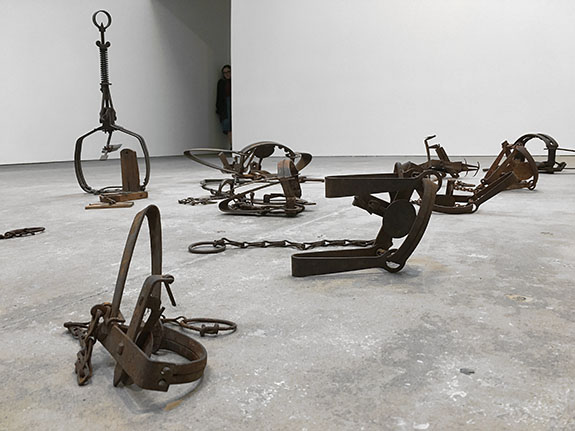
I was intrigued and mystified by Jay DeFeo’s 1987 collection of 40 black-and-white photocopies of tissue boxes, which conjures up a vision of a washing machine-size old Xerox machine. These images appear next to a 2017 Donnelly projection of spooky abstract video transmissions that flash at irregular intervals. Both works demonstrate the myriad ways artists are able endlessly transform objects using off-the-shelf consumer hardware, a subject touched on in a spate of recent DeFeo shows in San Francisco. Patricia L. Boyd’s trio of works, made from used restaurant grease (stabilized with beeswax and resin), show the imprinted ghosts of Aeron office chairs that once belonged to a failed start-up. Liquidated when it went bust, their remains are preserved as negative shapes in the refuse of the hipster eateries that once fed the company’s workers.
These pieces form an elliptical preamble to Harun Faroki’s insidiously dazzling 2007 video installation, Deep Play. Twelve projections surround us in a darkened carpeted room that reminded me of a Best Buy electronics showroom. The subject is the 2006 World Cup Final, 
movements, the other tracks heart rates, another turns the players into 3D animations, while another taps security cameras behind the bleachers. The installation emulates a media control room, a giant brain that analyzes the data of human experience. Watching makes us complicit, an integral part of this machinery. Do we begin to crave this overseer relationship?
It took a few visits to realize there was another piece that addresses the role of emotions within this investigation. A 50-minute video by young French artist Neil Beloufa concerns the mechanics of courtship, of love. Fittingly screened only on Saturday afternoons, Desire for Data, 2015, drops into a house party of American millennials where the mundane flirtations and jealousies are massaged by a beer pong tournament. The footage, it turns out, is being analyzed by a group of their peers, French college “mathletes” who, working in a classroom boasting classical nude sculptures that articulate flayed musculature, attempt to predict hook-ups by devising an algorithm based on
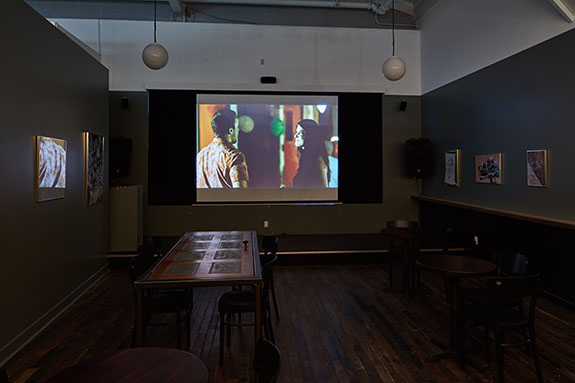
the input of inebriation, aspiration and physical beauty. This attempt to quantify passion is a fitting coda to the exhibition, posing trenchant questions about what we yearn for and expect from an exhibition — the warmth of emotional connection and aesthetic pleasure, or the cool structure of conceptual rigor. Mechanisms delivers on both counts.
# # #
“Mechanisms” @ The Wattis Institute through Februrary 24, 2018. The show also includes works by Park McArthur, Terry Atkinson, Jean-Luc Moulene, Zarouhie Abdalian, and Richard Hamilton. An expanded version of the show, “Other Mechanisms,” runs June 29 to September 2, 2018 @ Secession in Vienna.
About the author:
Glen Helfand is an independent writer and curator, as well as an associate professor at California College of the Arts.